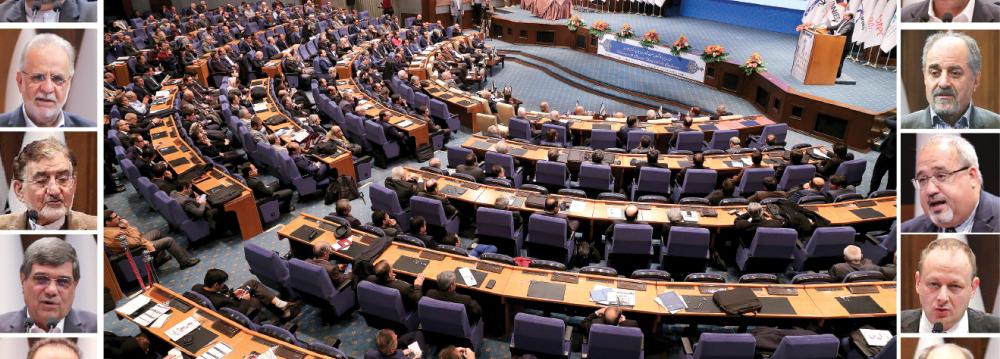The Iranian steel industry has survived the 2015-16 valley of death and is now reaping the benefits of an improving global market condition.
Its aggressive expansion is also moving ahead as planned, with a 55-million-ton crude steel capacity targeted for the 2025 deadline. Grave impediments, however, still remain in the industry’s way to true globalization and growth.
To discuss and find solutions to these roadblocks, Iranian government officials and steel industry players convened on Tuesday for the first day of the Eighth Iranian Steel Market Conference, also known as ISMC 2018, at the Islamic Republic of Iran Broadcasting's International Conference Center in Tehran.
With the industry’s worst days behind, the conference primarily showcased the growing chasm between private producers and state officials, with both sides emphasizing the necessity of dialogue for addressing hurdles related to exploration and capacity expansion.
“We believe that addressing the industry’s woes requires a dialogue among policymakers, industry experts and business owners,” said CEO of Donya-e-Eqtesad Media Group Alireza Bakhtiari whose company hosts the annual conference.
The main issues up for discussion, according to Bakhtiari, are the underdeveloped infrastructure, limitations on attraction of foreign finance, the government’s unclear role in steel expansion, lack of transparent regulations and long-term export policies and state-enforced pricing for certain products.
“Each of these issues carry a different weight for the private sector and the government … Bringing both together will help put an end to the vicious cycle troubling the industry,” he said.
Speaking on behalf of the private sector, Mehrdad Akbarian, the chairman of Iron Ore Producers & Exporters Association of Iran, echoed the same sentiments.
Private miners, he emphasized, have less bargaining power today due to the disparity between global and local prices.
Buyers consequently gain the upper hand, as iron ore miners are mandated by the government to prioritize local demand to feed the industry’s requirements for realizing the 2025 targets.
As part of the 20-Year Vision Plan, Iran aims to become the world’s seventh largest steelmaker after reaching a crude steelmaking capacity of amassing 55 million tons per year. Realizing the target requires over 160 million tons of iron ore.
“These are … negative signals for [potential investors in] the mining sector,” he said, noting that the costly financing of banks is further exacerbating the situation.
Addressing the conference, Minister of Industries, Mining and Trade Mohammad Shariatmadari defended the role of the government in the steel industry.
“The current lack of balance in the steel production chain is the result of a lack of government intervention, not its increased presence. The current imbalance did require both the government and [private] business associations to intervene. But they left it to the invisible hand, trusting investors’ instinct, which did not end up good,” he said.
“We have no inherent desire to interfere in the market, but certain times call for it … The Khouzestan Steel billet situation, for instance, was what the industry itself wanted back in the day, and the ministry only approved their proposal.”
The minister was referring to the years-old practice of calculating the price of certain iron and steel products based on a percentage of Khouzestan Steel Company’s billet price. The measure has recently come under private sector fire and was repeatedly denounced during the conference.
Shariatmadari also called on iron ore miners to sign long-term raw material supply deals with steel producers to both ensure increased financial safety and reduce their footprint in unprocessed iron ore exports.
Industry Challenges in Statistics
Top think tank Foolad Technic International Engineering Company pointed out the industry’s main bottlenecks for expansion through statistics.
According to Mohammad Abka, managing director of FIECO, Iran will require 168 million tons of iron ore, 86 million tons of concentrate, 87 million tons of pellet and 57 million tons of direct-reduced iron before it is able to meet the 2025 target.
For the past three years, raw material shortage has been one of ISMC’s main talking points. This year was no different, with iron ore shortage being the primary focus.
“We have 5 billion tons of estimated iron ore reserves, only 3.1 billion tons of which are proven. If we proceed with the current pace of iron ore expansion and usage, our reserves will last for 10 years after 2025,” Abka said.
On the plus side though, last year’s chronic DRI shortage has been reduced to 8 million tons and pellet expansion has already been balanced out.
Iran’s iron ore reserves need to expand through increased explorations, otherwise the country will become an iron ore importer post-2025, according to Bahram Shakouri, chairman of Iran Chamber of Commerce, Industries, Mines, Trade and Agriculture’s Mining Commission.
“[Without expanding explorations] we will have to import up to 61 million tons of iron ore per year after 2025. In order to avoid this, our deposits need to increase through exploration by 2.5% every year,” Shakouri said.
As for steel usage, the best-case scenario points to 30-million-ton consumption by 2025, according to FIECO. The government is more hopeful, as it expects to reach 45 million tons, based on the goals set in the Sixth Five-Year Development Plan (2017-22).
Iran per capita steel usage is about 230 kilograms—slightly higher than the world average of 208 kilograms, according to Mobarakeh Steel Company’s Managing Director Bahram Sobhani.
“We will have a 90 million population by 2025 and our usage will accordingly not be more than 350 kilograms with an 8% economic growth. This adds up to 31.5 million tons of usage in total,” Sobhani told the conference.
The leftover capacity must be exported, with the government official’s forecast being about 20 million tons, while FIECO’s target under the current market condition stands at about 10.5 million tons per year.
Iran’s steel expansion is growing in contrast to the global trend.
“We are not moving toward more value-added goods. We are currently exporting more semi-finished steel than products,” Abka said.
FIECO expects Iran to reach the target of 55-million-ton capacity four years earlier than the 2025 deadline. Nonetheless, exports and usage are not expected to grow accordingly.
Things become more challenging, as high production and transportation costs make the leftover capacity undesirable in export markets. Over 66 Iran’s steel plants operate at less than 500,000-ton-capacity and limited economies of scale, while only less than a quarter of steel is exported via Persian Gulf waters in the south—Iran’s sole cheap transportation option in the absence of a developed railroad infrastructure.
Scarce Foreign Investment
Iran needs €8 billion of investment for its 2025 steel expansion plans.
About €5.5 billion of it, according to the FIECO chief, have already been attracted mainly through local funding in the capital market and by the banking system.
Abka sounded confident in saying that Iran can realize the 2025 target without having to rely on foreign investment. However, he emphasized that any further expansion will be beyond Iran’s money market capabilities.
Iran has lagged behind in foreign investment attraction compared to many other countries in the region, such as India and Turkey, which have supercharged their industries using foreign financing.
The lifting of international sanctions as part of the 2015 nuclear deal, also known as the Joint Comprehensive Plan of Action, did its part to reintegrate Iran into the global economy. Yet it was not the elixir that some were hoping for, as the United States’ secondary sanctions remain in place and prevent major global banks to work with Iran. Financing Iran, therefore, is still risky and costly.



